11
Introduction
The most basic function of pull-up or pull-down resistors (collectively referred to as "pull resistors") is to clamp a signal line with an uncertain state to a high level (pull-up) or a low level (pull-down) through a resistor. Regardless of its specific usage, this basic function is the same. But in different application, the resistance value will be different, which leads to many new concepts.
This article mainly introduces the pull-up resistor and the pull-down resistor. Firstly, it introduces the pull-up resistor from its concept,function, fundamentals, disadvantages,selection principle and applications. Secondly, it introduces the pull-down resistor from concept, function, schematic diagram, typical circuit and setting principle. Finally, it introduces the commons of both the resistors like functions, wiring methods and selection and calculation.
Catalog
Introduction | |
ⅠPull-up Resistor | 1.1 Concept |
1.2 Function | |
1.3 Fundamentals | |
1.4 Disadvantages | |
1.5 The Picking up Principle of Pull-up Resistor | |
1.6 Reasons for Using | |
1.7 Applications | |
II Pull-down Resistor | 2.1 Concept |
2.2 Function | |
2.3 Schematic Diagram of Pull-down Resistor | |
2.4 Typical Circuit | |
2.5 Setting Principle | |
III The Functions of the Pull-up Resistor and Pull-down Resistor | 3.1 Improve Circuit Stability and Avoid Malfunctions |
3.2 Increase the Load Capacity of the Output Pins | |
IV Wiring Methods of Pull-up Resistor and Pull-down Resistor | |
ⅤPicking up and Calculation of Pull-up Resistor and Pull-down Resistor | |
I Pull-up Resistor
Pull-up resistor is to clamp the indeterminate signal through a resistor at a high level, and the resistor acts as a current limiter. The same is true for pull-down resistor, which also clamps the indeterminate signal through a resistor at a low level.
Pull-up resistor is the input current, pull-down is the output current; the resistance value of the pull-up resistor is different from that of the pull-down resistor, there is no strict distinction; the ability to provide current and voltage for non-collector (or drain) open-circuit output circuits (such as ordinary gate circuits) is limited. The function of the pull-up resistor is mainly to output the current channel for the open collector output type circuit.
1.1 Concept
The resistor that is drawn from the high level of the power supply is connected to the output.
(1) If the level is output with OC (Open Collector, TTL) or OD (Open-Drain, CMOS), then the pull-up resistor does not work. It is easy to understand that the tube cannot output a high level without a power supply.
(2) If the output current is relatively large, the output level will decrease (there is already a pull-up resistor in the circuit, but the resistance is too large and the voltage drop is too high), the pull-up resistor can be used to provide the current component and "raise" the level. That is, a resistor is placed on the pull-up resistor inside the IC, which makes the total resistance be reduced and makes the total current be increased. Of course, the pull-up resistor of the tube working in the linear range should not be too small. Of course, this method is also used to achieve the matching of the gate level.
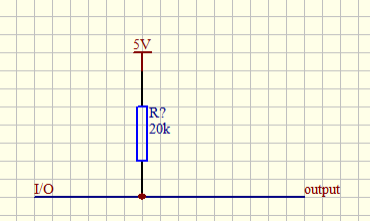
1.2 Function
(1) When a TTL circuit drives a CMOS circuit, if the output high level of the circuit is lower than the lowest high level of the CMOS circuit (generally 3.5V), it is necessary to connect the pull-up resistance at the output end of the TTL to improve the output high level.
(2) The OC gate must use a pull-up resistor to increase the high-level value of the output.
(3) To enhance the drive capability of the output pins, pull-up resistors are often used on the pins of some single-chip computers.
(4) On the CMOS chip, in order to prevent damage caused by static electricity, the unused pins cannot be suspended, and the pull-up resistor is generally connected to reduce the input impedance and provide a discharge path.
(5) The pin of the chip and the pull resistor are added to improve the output level, so as to improve the noise tolerance of the input signal of the chip and enhance the anti-interference ability.
(6) To improve the anti-electromagnetic interference capability of the bus, it is easier to accept external electromagnetic interference when the pins are suspended.
(7) Resistance mismatch in long-line transmission is likely to cause reflected wave interference, adding pull-up resistor and pull-down resistor is for resistance matching, effectively suppressing reflected wave interference.
1.3 Fundamentals
In the initial stage of powering up the digital circuit, since the high level and low level of the output state are uncertain, in order to make the circuit state correct, it is necessary to use pull-up resistor or pull-down resistor to stabilize the uncertain circuit state.
On the wire to which the pull-up resistor is connected, if the external component is not enabled, the pull-up resistor will weakly pulls the input voltage signal high. When the external components are not connected, the external looks high impedance to the input. At this point, the voltage at the input port can be pulled up to a high level by the pull-up resistor. If the external component is enabled, it will cancel the high level set by the pull-up resistor. In this way, the pull-up resistor allows the pin to maintain a certain logic level even when the external components are connected.
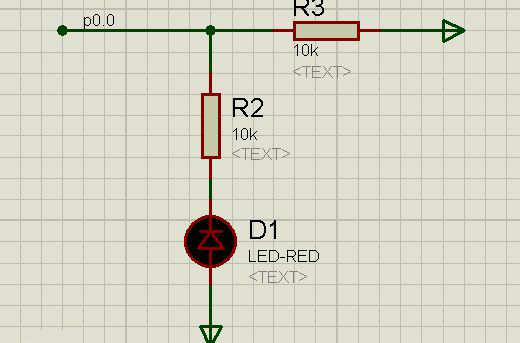
1.4 Disadvantages
The disadvantage of the pull-up resistor is that it will consume additional energy as current flows through it and may cause a delay in the output level.
Some logic chips are sensitive to the transient state of the power supply introduced through the pull-up resistor, thus forcing a separate, filtered voltage source for the pull-up resistor.
Noting: it should be noted that too large a pull-up resistor will cause a delay in the output level.(RC delay)
Generally, the CMOS gate circuit output can not be suspended, and is connected with pull-up resistor to set a high level.
1.5 The Picking up Principle of Pull-up Resistor
(1) From the perspective of saving power consumption and the current sinking capacity of the chip, it should be large enough, large in resistance, and small in current.
(2) From the perspective of ensuring sufficient drive current, it should be small enough, low resistance, and large current.
(3) For high speed circuits, excessive pull-up resistance may flatten the edges.
Considering the above three points, the resistance of the pull-up resistor is usually selected from 1k to 10k.
1.6 Reasons for Using
Generally, when the single button is used for triggering, if the IC itself does not have an internal resistor, in order to maintain the single button in the untriggered state or return to the original state after the trigger, another resistor must be connected outside the IC.
Digital circuits have three states: high level, low level and high-impedance state.
When some applications do not need high-impedance state, they can be stabilized by pull-up resistors or pull-down resistors, depending on design requirements.
1.7 Applications
A pull-up resistor can be placed between the connection logic gate and its input terminal. For example, an input signal can be pulled high by a resistor, and a switch or jumper can connect the input to the ground. Pull-up resistors can operate when the logic device is not providing current.
The open collector has a pull-up resistor, and such a circuit output signal is often applied in the cases of driving external devices, combinational logic circuits, and a plurality of devices connected to one bus.
For example, the circuit shown on the right uses 5 volts to excite a repeater. If the input on the left is not connected, the pull-down resistor R1 ensures that the input signal is pulled low. The 7407TTL series is a collector buffer that outputs only the input signals it receives. But for the right device, since it is a TTL type device, when it outputs a high level, it is equivalent to the unconnected device for the right side. At this time, the pull-up resistor R2 pulls up the output signal to 12 volts, which provides enough voltage for the next stage FET to turn on, thereby activating the relay.
II Pull-down Resistor
Pull-up resistor is to clamp the uncertain signal through a resistor at a high level, and the resistor acts as a current limiter at the same time. The principle of setting the pull-down resistor is the same as the pull-up resistor.
The pull-down resistor is directly connected to the ground, and the end of the resistor is at low level when connected to the diode.
2.1 Concept
(1) Connect an uncertain signal to the ground GND through a resistor and fix it at a low level.
(2) Pull-down is the output current from the device.
(3) When an IO port with a pull-down resistor is set to the input state, it is normally at low level.
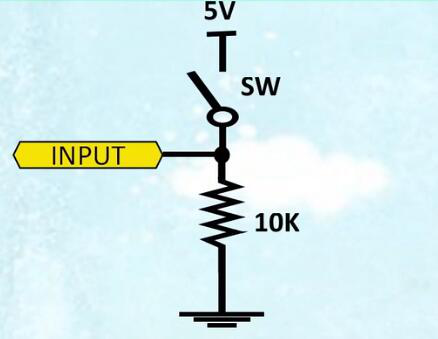
2.2 Function
The main function of the pull-down resistor is to provide the line (node) with a fixed level when the circuit driver is turned off together with the pull-up resistor.
(1) Increase voltage level
a.When a TTL circuit drives a CMOS circuit, if the output high level of the circuit is lower than the lowest high level of the CMOS circuit (generally 3.5V), it is necessary to connect the pull-up resistance at the output end of the TTL to improve the output high level.
b.The OC gate must use a pull-up resistor to increase the high-level value of the output.
(2) To enhance the drive capability of the output pins, pull-up resistors are often used on the pins of some single-chip computers.
(3) On the CMOS chip, in order to prevent damage caused by static electricity, the unused pins cannot be suspended, and the pull-up resistor is generally connected to reduce the input impedance and provide a discharge path.
(4) Resistance mismatch in long-line transmission is likely to cause reflected wave interference, adding pull-up resistor and pull-down resistor is for resistance matching, effectively suppressing reflected wave interference.
(5) Preset space state / default potential: on some CMOS input terminals, the pull-up resistors or pull-down resistors are designed to preset the default potential. When these pins are not used, these inputs are pulled down to 0 or pulled up to 1.
(6) Improve the noise margin of the chip input signal: if the input terminal is in a high-impedance state, or the high-impedance input terminal is in a suspended state, it needs to add a pull-up resistor or a pull-down resistor at this time to avoided affecting the circuit operation for receiving the random level. Similarly, if the output is in a passive state, it needs to add a pull-up resistor or a pull-down resistor , for example, the output is just a collector of a triode. Thus, the noise margin of the input signal of the chip is improved and the anti-interference ability is enhanced.
2.3 Schematic Diagram of Pull-down Resistor
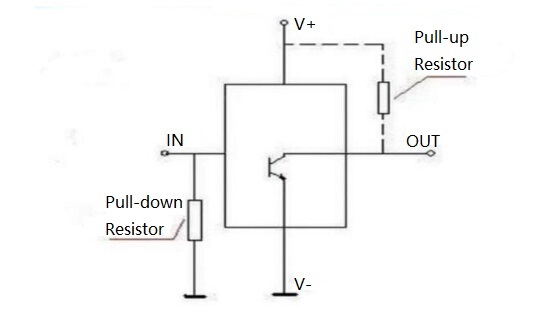
2.4 Typical Circuit
The following figure shows the pull-down resistor circuit.
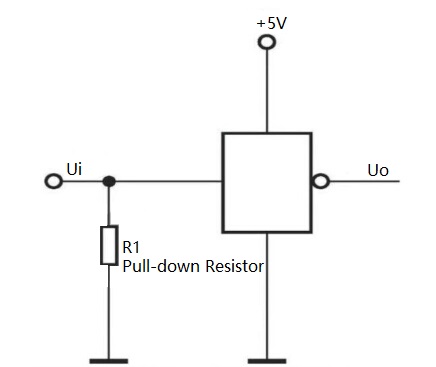
This is the inverter in the digital circuit. The input terminal Ui is grounded through the pull-down resistor R1, so that when there is no high-level input, the input terminal can be stably in a low-level state, preventing possible high-level interference from malfunctioning the inverter.
When the pull-down resistor R1 is connected and the power supply voltage is 5 volts, the pull-down resistor R1 is generally from 100 to 470 ohms. Since the resistance value of R1 is very small, the various high-level interferences at the input terminal are connected to ground to achieve the purpose of anti-interference.
2.5 Setting Principle
Its principle is the same as the pull-up resistor. The selection of the pull-down resistor should be set in combination with the characteristics of the switching transistor and the input characteristics of the lower-level circuit. The following factors should be considered.
(1) Balance of Driving Capability and Power Consumption
Take the pull-up resistor as an example. Generally speaking, the smaller the pull-up resistance, the stronger the driving ability, but the greater the power consumption, the more attention should be paid to balance between the both resistors.
(2) Driving Requirements of Lower-level Circuits
Take the pull-up resistor similarly for example. When the output is high and the switch is turned off, and the pull-up resistor should be properly selected to provide sufficient current to the lower-level circuit.
(3) Setting of high level and low level
The threshold levels of the high level and low level varies from different circuits, and the resistor should be properly set to ensure that the correct level can be output. Take the pull-up resistor as an example. When the output is low and the switch is turned on, the pull-up resistor and the on-off resistor of the switch should be kept below the zero-level threshold.
(4) Frequency characteristics
Take the pull-up resistor as an example. The capacitance between the pull-up resistor and the drain-source stage of the switch and the input capacitance between the lower-level circuits form an RC delay. The larger the resistance, the greater the delay.
When the OC gate outputs a high level, it is a high-impedance state, and its pull-up current is provided by a pull-up resistor. The output voltage of OC gate is a high resistance state, and its pull-up current is provided by a pull-up resistor. Assume that the input port is no more than 100uA per port and the output current of the output port is about 500uA, the standard operating voltage is 5V, and the threshold of high level and low level of the input port is 0.8V (below this value is low level).
III The Functions of the Pull-up Resistor and Pull-down Resistor
3.1 Improve Circuit Stability and Avoid Malfunctions
If the button in the first figure is not pulled up to the high level through the resistor, then the power may be malfunctioned at the moment of power-on, because the pin level of the microcontroller is uncertain at the moment of power-on. But the pull-up resistor R12 ensures that the pin is in a high state without malfunction.
3.2 Increase the Load Capacity of the Output Pins
The influence of other peripheral circuits on the microcontroller is insufficient in output high level, which does not reach the VCC state, which will affect the normal operation of the whole system. The presence of the pull-up resistor can enhance the driving capability of the pin. Here is especially emphasized as follows:
For a microcontroller with on-chip I2C resources, the SCL and SDA pins are open-drain pins. If used as a normal GPIO, you will find that the output of this pin is extremely unstable and cannot be output normally due to load. At this time, you need to add a pull resistor on these two pins.
IV Wiring Methods of Pull-up Resistor and Pull-down Resistor
Pull-up resistor and pull-down resistor are used in digital circuits, where there are high and low levels.
Pull-up resistor: one end of the resistor is connected to VCC, and the other end is connected to a logic level access pin (such as a MCU pin).
Pull-down resistor: one end of the resistor is connected to GND, and the other end is connected to a logic level access pin (such as a MCU pin).
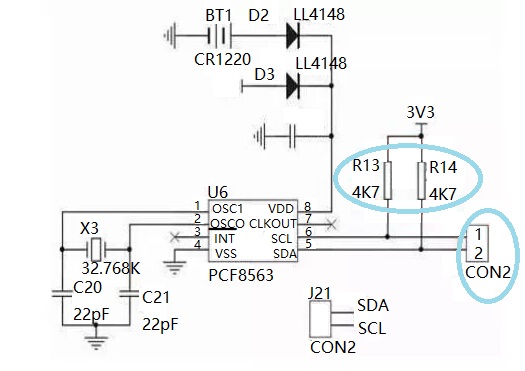
As shown above, R13 and R14 are connected to 3.3V at one end, and the other end is connected to the MCU pins through J17. These two resistors are pull-up resistors.
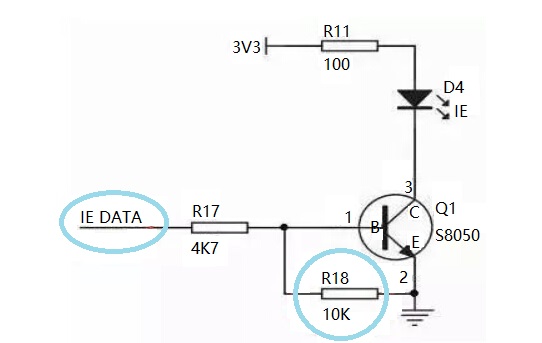
As shown above, one end of R18 is connected to GND, and the other end is connected to the pin of the microcontroller (just strings a resistor and connects to the pin of MCU). So this is the pull-down resistor.
Ⅴ Picking up and Calculation of Pull-up Resistor and Pull-down Resistor
On the common technical data, some technical specifications write that "useless pins are not allowed to be suspended and must be connected with pull-up or pull-down resistors to provide a definite working state".
This idea is basically correct, but not all right. Details are given below.
There are two starting points for the design of pull-up resistor and pull-down resistor on the pins.
Firstly, in normal operation or single failure state, the pin should not be in an indeterminate state, such as the pin suspension caused by the connector falling off;
Secondly, from the point of view of power consumption, the resistance of the pin port should not consume too much current, especially for battery-powered devices, when the pin is waiting for a long time.
From the perspective of immunity, the signal port is preferred to a pull-up resistor. When pulling up resistance, in standby state, the input of the source terminal is usually in high-impedance state. If there is no pull-up resistor or pull-down resistor, the input conductor presents an antenna effect. Once the pin is disturbed by radiation, the input state of the pin is very easy to be induced to change. Therefore, this resistor is sure to be added. The next question is whether to add a pull-up resistor or a pull-down resistor.
If the pull-down resistor is added, the input will present a low level in the normal state, but when there is a radiation interference, it will be discharged to the ground through the pull-down resistor, and a jump from Low to High will occur, causing a false trigger.
However, if the pull-up resistor is added, the input will present a high level in the normal state. After the radiation interference occurs, it does not matter even if the input is in a low level, because the pull-up resistor clamps the input terminal to a high level. If the radiation interference is strong enough to exceed the level of Vcc, the high-level interference on the conductor will be discharged to Vcc through the pull-up resistor. No matter how the interference occurs, only the change from High to Higher will occur, and false triggering will not occur.
Figure 1 and figure 2 are the level diagrams in the interference state. When the low level in figure 2 is changed from VL to VL+ΔV, a transition from a low level to a high level occurs, which may lead to the risk of malfunction of the subsequent stage circuit.
After using the pull-up resistor, is it possible to pick up the pull-up resistor at will?
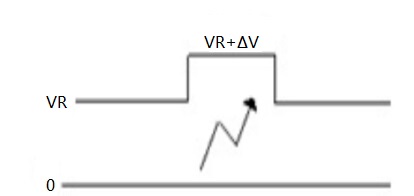
Figure 1.
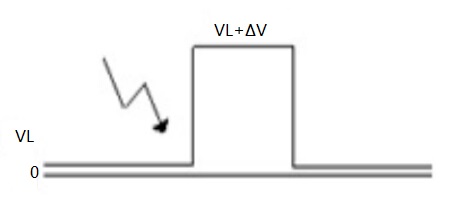
Figure 2.
When the front pole outputs a high level, vout outputs current and U is high.
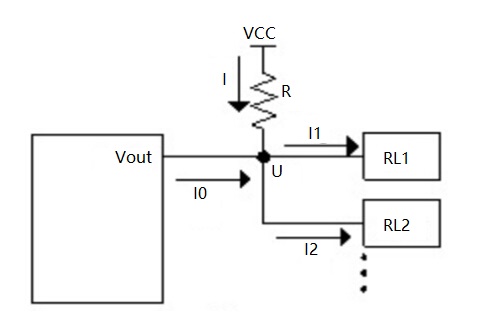
There are two situations:
a. When I0 >= I1 + I2
In this case, the two loads of RL1 and RL2 do not take current through R, so the R resistance value is not required to be high, usually 4.7 KΩ<R<20 KΩ. At this time, the main function of R is to increase the reliability of the signal. When the vout connection is loose or falling off, the suppression circuit generates a whip antenna effect to absorb interference.
b. When I0 < I1 + I2
I0 +I= I1 + I2
U=VCC-IR
U>=VHmin
The above three formulas can be concluded: R>=(VCC- VLmax)/I’
From the above two formulas, the upper and lower limits of R can be calculated, from which a value closer to the intermediate state can be taken. Note that if the number of loads is uncertain, it should be calculated according to the worst case, the upper limit value should be calculated according to the maximum load, and the lower limit value should be calculated according to the minimum load.
The upper limit should be calculated according to the maximum load, and the lower limit should be calculated according to the least load.
Another option is based on power consumption considerations. According to the actual application of the circuit, the frequency or time ratio of the output signal state is selected. If the signal vout is at low level for a long time, pull-down resistor should be chosen; if it is at high level for a long time, pull-up resistor should be chosen. Therefore, the quiescent current will be small.
You May Also Like:
How to Test Different Kinds of Resistors with a Pointer Multimeter
What Are the Functions and Applications of the Varistor?
How to Test Ground Resistance?
What is the giant magnetoresistance (GMR)?
Ordering & Quality
| Photo | Mfr. Part # | Company | Description | Package | Qty |
|
MMA2204KEGR2 | Company:Freescale Semiconductor - NXP | Remark:ACCELEROMETER 112.5G ANAL 16SOIC | Package:16-SOIC (0.295", 7.50mm Width) |
MMA2204KEGR2 Datasheet |
In Stock:1330 Inquiry |
Inquiry |
|
SL811HST-AXC | Company:Cypress Semiconductor Corp | Remark:IC USB HOST/SLAVE CTRLR 48TQFP | Package:TQFP |
SL811HST-AXC Datasheet |
In Stock:15200 Inquiry |
Inquiry |
|
ATTINY13A-SUR | Company:Microchip | Remark:IC MCU 8BIT 1KB FLASH 8SOIC | Package:08LSOIJ |
ATTINY13A-SUR Datasheet |
In Stock:7060 Inquiry |
Inquiry |
|
BAT54HT1G | Company:ON Semiconductor | Remark:DIODE SCHOTTKY 30V 200MA SOD323 | Package:SOD323 |
BAT54HT1G Datasheet |
In Stock:995379 Inquiry |
Inquiry |
|
MPC8533EVTANG | Company:NXP / Freescale | Remark:IC MPU MPC85XX 800MHZ 783FCBGA | Package:783-BBGA, FCBGA |
MPC8533EVTANG Datasheet |
In Stock:79 Inquiry |
Inquiry |
|
RC0603FR-071KL | Company:Yageo | Remark:RES SMD 1K OHM 1% 1/10W 0603 | Package:SMD |
RC0603FR-071KL Datasheet |
In Stock:39061200 Inquiry |
Inquiry |
|
MC9S08JR12FAE | Company:NXP / Freescale | Remark:IC MCU 8BIT FLASH 48LQFP | Package:48-LQFP |
MC9S08JR12FAE Datasheet |
In Stock:83598 Inquiry |
Inquiry |
|
70V34L20PFI8 | Company:IDT | Remark:SRAM 4K x 18 3.3V Dual-Port RAM | Package: |
70V34L20PFI8 Datasheet |
In Stock:95 Inquiry |
Inquiry |
|
RCL1218100RFKEK | Company:Vishay | Remark:RES SMD 100 OHM 1W 1812 WIDE | Package:Wide 1812 (4532 Metric), 1218 |
RCL1218100RFKEK Datasheet |
In Stock:5040 Inquiry |
Inquiry |
|
MCIMX507CVM8B | Company:NXP / Freescale | Remark:IC MPU I.MX50 800MHZ 400MAPBGA | Package:400-LFBGA |
MCIMX507CVM8B Datasheet |
In Stock:607 Inquiry |
Inquiry |